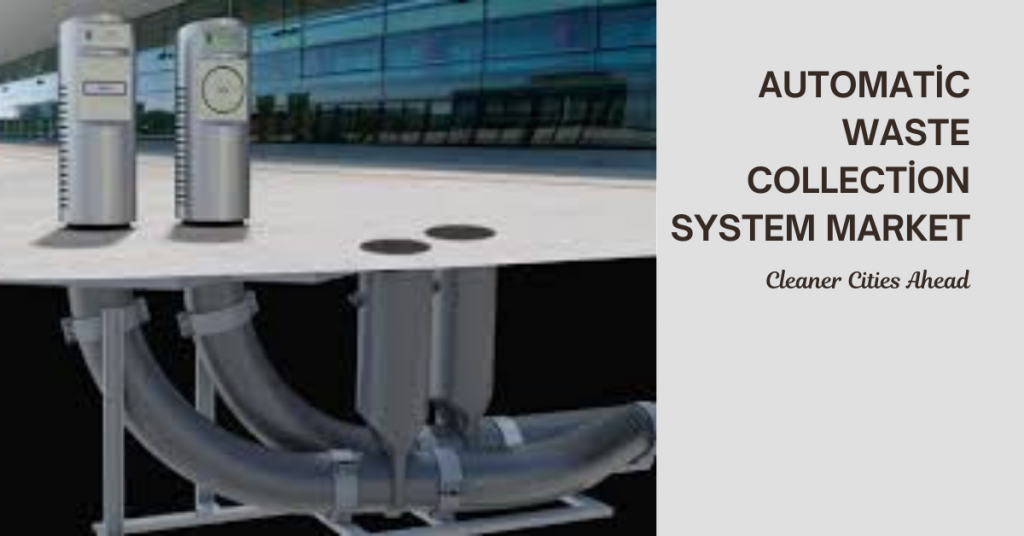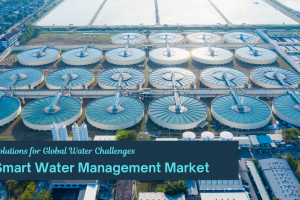
Market Overview
The Automatic Waste Collection System Market size was valued at USD 364.36 million in 2024 and is anticipated to reach USD 792.4 million by 2032, registering a CAGR of 10.2% during the forecast period (2024–2032). This market is gaining traction due to increasing urbanization, rising environmental concerns, and the growing demand for efficient waste management solutions worldwide. Automatic waste collection systems leverage vacuum technology and automated conveyance infrastructure to optimize waste collection, reducing manual labor and improving hygiene. These systems are particularly beneficial in densely populated areas where traditional waste handling can be labor-intensive and inefficient.
The relevance of automatic waste collection systems has intensified with the increasing emphasis on sustainable urban development and smart city initiatives. These systems facilitate the segregation, collection, and transportation of waste in residential, commercial, and industrial zones, minimizing environmental pollution and operational costs. Governments and municipalities across regions such as North America, Europe, and Asia Pacific are actively investing in these technologies to streamline waste management practices. Additionally, the rising adoption of automation in municipal services underlines the strategic importance of this market. Public-private partnerships are also contributing significantly to the deployment of these systems in urban planning projects.
As environmental regulations tighten and waste volumes surge, the market’s growth trajectory is poised to accelerate. Integration with IoT and AI technologies further enhances system efficiency, enabling real-time monitoring and predictive maintenance. With expanding infrastructure and increased funding for urban waste solutions, the automatic waste collection system market is well-positioned to witness robust growth through 2032. The combination of environmental imperatives and technology-driven innovations makes this sector critical for future-ready urban development.
Read full report: https://www.credenceresearch.com/report/automatic-waste-collection-system-market
Market Drivers
Growing Urbanization and Waste Generation
Rapid urbanization has led to an unprecedented increase in municipal solid waste worldwide. Automatic waste collection systems offer efficient solutions for managing large volumes of waste, ensuring hygienic and timely collection. For instance, expanding metropolitan areas in Asia Pacific generate substantial waste, driving demand for automated solutions. Cities like Mumbai, Jakarta, and Shanghai are facing daily waste challenges that cannot be solved by conventional means alone. With the rise in population density, these systems help in reducing congestion caused by traditional waste trucks. Additionally, they enhance city aesthetics by eliminating the need for curbside bins and frequent collection rounds.
Government Regulations and Environmental Policies
Stringent environmental regulations and policies aimed at reducing landfill waste and greenhouse gas emissions are compelling municipalities to adopt advanced waste management systems. Recent studies indicate a 15% increase in government-funded projects supporting automated waste infrastructure, particularly in Europe and North America. These systems align with international climate targets, including the Paris Agreement goals. Municipalities are incentivized through green grants and sustainability awards to implement such infrastructure. Moreover, waste reduction mandates are encouraging the use of tech-based systems to meet compliance. Public awareness campaigns are also reinforcing the benefits of automated systems in reducing environmental harm.
Technological Advancements
Continuous innovations in sensor technologies, vacuum systems, and automation software are improving system reliability and cost-efficiency. The integration of IoT allows for better route optimization and waste volume monitoring, which is crucial for commercial and residential applications. New AI algorithms can now predict system malfunctions before they occur, reducing downtime. Sensor-based bin tracking improves responsiveness and avoids overflow issues. Integration with mobile apps enables user interaction and efficient feedback systems. These advancements are pushing companies to enhance their R&D capabilities and collaborate with tech startups for competitive advantages.
Increasing Focus on Smart Cities
Smart city initiatives worldwide emphasize sustainability and efficiency. Automatic waste collection systems align with these goals by reducing operational costs, minimizing manual labor, and promoting cleaner urban environments. For example, smart city projects in the GCC countries have incorporated these systems to enhance waste management. They are part of broader digital infrastructure upgrades that include traffic, lighting, and utility automation. The systems are also being deployed in smart campuses and industrial clusters. City planners are increasingly factoring in waste automation during the master planning stage. The alignment with sustainable urban mobility and infrastructure makes these systems indispensable in smart urban ecosystems.
Market Challenges
High Initial Capital Investment
The implementation of automatic waste collection systems requires substantial upfront investment in infrastructure and technology, posing a barrier for smaller municipalities or developing regions. This cost factor slows adoption despite long-term operational savings. Often, budget limitations restrict project scale and scope. Governments may prioritize other pressing infrastructure needs over waste automation. Additionally, securing financial backing from private investors can be difficult due to perceived risk. High procurement costs of system components further elevate the investment threshold.
Complex Installation and Maintenance
Setting up the pneumatic networks and vacuum stations involves complex engineering, which may disrupt existing urban infrastructure. Additionally, maintenance requires skilled personnel and ongoing technical support, which can strain resources. Retrofitting older neighborhoods with underground piping is particularly challenging. Coordination among multiple departments often leads to delays. Regular maintenance and part replacements also add recurring costs. These factors collectively increase the system’s lifecycle expenses and reduce adoption willingness.
Regulatory Hurdles and Compliance Issues
Navigating local regulations regarding waste disposal, health, and safety can delay projects. Diverse standards across countries add complexity to market expansion for global players. Municipal approvals are often lengthy and subject to public consultations. Environmental impact assessments may stall projects. Compliance with building codes and underground infrastructure regulations varies widely. These delays not only escalate costs but also discourage international players from entering fragmented markets.
Competition from Conventional Waste Systems
Traditional manual and semi-automated waste collection methods still dominate many markets due to their lower initial cost and established presence, limiting the penetration rate of fully automated systems. Public sector procurement often favors familiar technologies. Lack of awareness about long-term savings deters decision-makers. Workers’ unions may resist automation, fearing job losses. These social and economic factors strengthen the hold of conventional systems and slow transition.
Market Opportunity
Expansion in Emerging Economies
Rapid urban growth and increasing environmental awareness in countries like India, Brazil, and South Africa offer vast untapped markets. Municipalities here are progressively investing in modern waste infrastructure. Urban policy reforms are creating favorable conditions for infrastructure upgrades. International development banks are funding eco-friendly urbanization projects. These regions are also seeing population shifts from rural to urban centers, increasing demand for efficient systems. The focus on improving sanitation further accelerates interest.
Integration with IoT and AI Technologies
The incorporation of smart technologies enables predictive maintenance and operational efficiency, presenting growth opportunities for companies offering advanced solutions. Real-time tracking and analytics help in optimizing energy and resource usage. AI can also support dynamic waste collection scheduling. Startups and tech firms are collaborating to develop integrated platforms. Future-ready systems can also link with other smart city services, enhancing overall urban functionality.
Growing Commercial and Healthcare Applications
Beyond residential use, commercial establishments, hospitals, and airports increasingly require automated waste systems to manage specialized waste streams, driving demand for customized solutions. Clean and sterile environments are critical in healthcare. Hotels and shopping malls prefer seamless, odor-free waste disposal. Industrial parks are seeking centralized waste systems to reduce logistics costs. Customized solutions open doors for niche market players.
Sustainability and Circular Economy Initiatives
Rising emphasis on waste recycling and resource recovery fosters market growth, as automatic systems support efficient waste sorting and segregation at source, enabling circular economy practices. These systems reduce landfill dependency. Governments are rolling out incentive schemes for resource recovery. Public-private partnerships are being explored to drive circular economy models. Sustainable waste solutions are now part of ESG compliance for large organizations. These initiatives make automated systems a strategic fit.
Market Segmentation
By Equipment Type:
- Waste Inlets
- Conveying Pipes
- Collection Stations
- Air Handling Units
- Valves and Sensors
By Application:
- Residential
- Commercial
- Industrial
- Healthcare
- Transportation Hubs
- Educational Institutions
By Technology:
- Full Vacuum System
- Gravity Vacuum System
By Automation Level:
- Semi-Automated Systems
- Fully Automated Systems
By End-User Industry:
- Municipalities
- Airports
- Hospitals
- Shopping Centers
- Universities
- Real Estate Developers
Based on Geography:
North America
- U.S.
- Canada
- Mexico
Europe
- Germany
- France
- U.K.
- Italy
- Spain
- Rest of Europe
Asia-Pacific
- China
- Japan
- India
- South Korea
- Southeast Asia
- Rest of Asia-Pacific
Latin America
- Brazil
- Argentina
- Rest of Latin America
Middle East & Africa
- GCC Countries
- South Africa
- Rest of the Middle East and Africa
Regional Analysis
North America
North America holds a significant share of the market, driven by strict environmental regulations and high infrastructure investments. The U.S. and Canada lead with smart city projects integrating automated waste systems in urban and suburban areas. Cities like San Francisco and Toronto are early adopters. Government grants and sustainability mandates encourage public sector adoption. The region also benefits from established technology providers and mature logistics networks. Public-private partnerships are crucial in funding large-scale deployments. Awareness campaigns also drive public acceptance of these systems.
Europe
Europe is a mature market with widespread adoption in countries like Germany, France, and the UK. Strong governmental policies supporting sustainability and waste reduction initiatives boost market growth. Scandinavian countries also show high uptake due to advanced environmental standards. EU-wide directives on landfill reduction and recycling targets are accelerating deployment. Urban planning authorities include waste automation in city master plans. Cross-border technology collaborations are fostering innovation. Public perception is highly favorable toward automation in waste handling.
Asia Pacific
Asia Pacific is the fastest-growing market, fueled by rapid urbanization in China, India, and Southeast Asia. Increasing municipal investments and public-private partnerships are pivotal in expanding infrastructure for automated waste management. Mega cities are struggling with daily waste volumes. Smart city initiatives like India’s AMRUT and China’s urban development policies support this market. Local governments are partnering with international firms for pilot projects. Rising consumer awareness is encouraging faster policy implementation.
Latin America
Emerging economies such as Brazil and Argentina are witnessing gradual adoption due to growing environmental consciousness and urban infrastructure development, though budget constraints remain a challenge. Environmental NGOs are playing a pivotal role in advocacy. Government-backed pilot projects are in progress in major cities. Technical collaboration with foreign companies is on the rise. Limited local expertise is being offset by training programs. Regional development funds may improve adoption in the near future.
Middle East & Africa
The Middle East is adopting automated systems mainly in GCC countries due to smart city projects. South Africa is leading in Africa, though the region overall faces slower adoption due to infrastructural and economic factors. High-income urban zones in the UAE and Saudi Arabia are prioritizing smart waste systems. Regional governments are aligning infrastructure upgrades with Vision 2030 agendas. Africa’s growth is driven mainly by donor-funded urban projects. Deployment is focused in metropolitan hubs rather than rural areas.
Top Companies
- Envac Group
- Stream Environment Sdn. Bhd.
- Cleantech Group
- Dansk Skraldesug ApS
- AMCS Group
- Caverion Corporation
- AWC Berhad
- Greenwave Solutions
- Aerbin ApS
- MariMatic Oy
Future Outlook
- The Automatic Waste Collection System market is expected to grow steadily as cities focus on sustainable waste management solutions.
- Technological advancements, such as IoT integration and AI-driven monitoring, will improve system efficiency and user experience.
- Expansion into emerging economies will create new demand due to rising urbanization and smart city initiatives.
- Increased government incentives and subsidies will encourage municipalities to adopt automated waste collection systems.
- AWCS adoption will rise in high-traffic sectors like airports, hospitals, and commercial complexes for improved hygiene and efficiency.
- Future designs will emphasize modular and scalable systems to suit diverse urban environments and infrastructure constraints.
- Integration with other smart city infrastructure will allow centralized control and data-driven waste management strategies.
- Enhanced sensor technology will lead to more accurate waste level detection, reducing operational costs.
- Environmental concerns and zero-emission goals will boost demand for AWCS as a sustainable alternative to traditional collection methods.
- Collaboration among technology providers, municipalities, and developers will drive innovation and market penetration globally.
Read full report: https://www.credenceresearch.com/report/automatic-waste-collection-system-market










